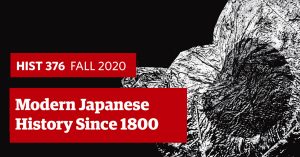
“All of these incidents [in Japanese history] are connected by people who have wanted to make a change to the world around them and either used images or were depicted in images as heroes and villains.”
Kelly McCormick is a historian of modern visual and material culture. She writes about “everything from advertising strategies and the design of Japanese products, to photographs of protests”, and is invested in understanding how visual culture, and especially, photography has been used to construct issues of race, class, and gender in modern Japan. She’s currently working on a book on the history of the first female photojournalists in Japan, and the changing meanings of photography as a mass practice.
I talked to her about her upcoming course, HIST 376: Modern Japanese History Since 1800. What is her approach to the history of Japan?
What is your course about?
This class is about how everything from the design of a building to advertising for makeup has been used to make an argument about what it meant to be a modern Japanese citizen. We will dive into modes of resistance and control from a range of perspectives including: female anarchists, government agencies, artists, indigenous voices, the Korean diaspora, architecture, the mass media, activists and protestors. These divergent voices and the images they created help us understand the constructions of gender, nationalism, class, race, and empire in the 19th and 20th centuries in Japan.
What will students take away from this course (skills, useful knowledge for other work, a new appreciation for this subject, etc)?
First, students will develop visual literacy; that is, we will be collectively understanding how to analyze the arguments that images make and how they construct power. Second, using their skills in visual literacy to create their own arguments about the past, students will learn how to write evidence-based interpretations of culture, society, and politics.


Kelly McCormick
How is the workload distributed? What should students expect in terms of assignments and reading?
Each week students will watch a brief lecture and have a short related reading. Instead of traditional writing assignments, in this course students will produce “Visual Essays.” Students will choose a series of images from primary source databases we will look at and, much like the editor of a magazine, arrange them to create a visual argument and pair them with their own original text about the story that these images tell and how they fit into the larger picture of issues we are discussing in the course referencing readings from the course.
What aspect of the course- a specific lecture, an assignment, a guest lecturer, a film, a certain topic, etc- are you most excited for your students to experience?
I am really excited to explore a range of online archives of images from magazine advertisements and posters, to maps, prints, paintings, postcards, and photographs together to discover materials that we have never seen before. One of the best parts of this class is how the students’ own unique perspectives will contribute to the way we interpret materials. We will all benefit from the insights you share on the difficult topics we cover, such as racism and forced sexual slavery in the Japanese colonial empire or the atomic bombing of Japan, as well as find more complex ways to look at what might seem like a “light” topic such as the design of the 1964 Tokyo Olympics or the construction of mass housing projects.
Give us a cool or weird fact about this historical topic.
Did you know that in 1911 the female anarchist Kanno Sugako was put to death for her plot to assassinate the emperor? Or that the first woman to become a photojournalist in Japan was a propaganda photographer for the government during World War Two? Or that one of the ways to see images of the bombings of Nagasaki and Hiroshima during the period of strict American censorship of information about the bombings (1945-1952) was a series of vividly graphic paintings that the artists Iri and Toshi Maruki took on a trip around Japan? All of these incidents are connected by people who have wanted to make a change to the world around them and either used images or were depicted in images as heroes and villains.
What’s something interesting about you that your students might not expect?
I will try almost anything once, so recently I went skydiving!
Register for HIST 376A here.
Find out more about Kelly McCormick’s work here.


